GE Cardioserv User manual

CardioServ
Version 4.2
Operator’s Manual
227 446 32 Revision I
The product CardioServ bears the  marking
marking
 -0459 (notified body GMED)
-0459 (notified body GMED)
indicating its conformity with the provisions of the Council Directive 93/42/EEC concerning medical devices and fulfills the essential requirements of Annex I of this directive.
The product complies with the electromagnetic immunity requirements of standard IEC 60601-1-2/EN 60601-1-2
“Electromagnetic Compatibility – Medical Electrical Equipment”.
The device is in radio-interference protection class B in accordance with CISPR11/EN 55011.
The CE marking covers only the accessories listed in section
“Order Information and Accessories”.
This manual describes CardioServ with all options included and reflects software version 4.13.
The authorized representative for GE Medical Systems Information Technologies Inc. in Europe is:
GE Medical Systems
Information Technologies GmbH
Munzinger Str. 3
D-79111 Freiburg, Germany
Tel. +49 (0) 7 61 45 43-0
Fax: +49 (0) 7 61 45 43-233
The country of manufacture appears on the device label.
© Copyright 2005 GE Medical Systems Information Technologies GmbH
Revision History
This document is subject to the GE Medical Systems Information Technologies GmbH change order system. The revision code, a letter that follows the document part number, changes with every update of the manual.
Part No./Revision Code |
Date |
Comment |
|
227 446 32 |
29 |
April 1997 |
Initial Release |
227 446 32-A |
14 |
May 1997 |
SW version 4.1 |
227 446 32-B |
1 July 1997 |
ECO 202998 |
|
227 446 32-C |
9 July 1998 |
ECO 060477 |
|
227 446 32-D |
6 August 1999 |
ECO 062982 |
|
227 446 32-E |
11 June 2001 |
ECO 066990 |
|
227 446 32-F |
15 October 2003 |
ECO 074738 |
|
227 446 32-G |
13 January 2004 |
ECO 075566 |
|
227 446 32-H |
20 December 2004 |
ECO 079412 |
|
227 446 32-I |
28 |
July 2005 |
ECO 080432 |
2 |
CardioServ V 4.2 |
227 446 32-I |

Contents
1.Introduction to CardioServ
2.Controls and Indicators
3.Setup and Performance Test
4.Non-Synchronized Defibrillation
5 Cardioversion (Synchronized Defibrillation)
6.Displaying and Monitoring the ECG
7.The Memories of CardioServ
8.Recording
9.Oxygen Saturation SpO2
10.Pacing
11.Configuring the Defibrillator Settings
12.Error Indications and Messages
13.Cleaning, Maintenance and Disposal
14.Technical Specifications
15.Order Information and Accessories Appendix
Index
227 446 32-I |
CardioServ V 4.2 |
3 |

General Information
General Information
*This manual is an integral part of the instrument and describes its normal use. It should always be kept close to the equipment. Observance of the manual is a prerequisite for proper instrument performance and correct operation and ensures patient and operator safety.
*The symbol denotes: Refer to Operator’s Manual!
It serves as an indicator for important facts to be noted when operating the instrument.
*Information which refers only to certain versions of the instrument is accompanied by the part number(s) of the instrument(s) concerned. The part number is given on the instrument nameplate.
*Patient safety, specified measuring accuracy, and interfer- ence-free operation can be guaranteed only if original GEMS IT devices are interconnected (e.g. basic units and plug-in modules).
*Only use accessories which are listed in this manual or which have been tested in combination with the device (e.g. patient cables, electrodes, transducers, sensors, consumables, etc.). If you use accessories or consumables from other manufacturers, GEMS IT does not guarantee safe operation or functioning of the device.
*The warranty does not cover damage resulting from the use of accessories and consumables from other manufacturers.
*GEMS IT considers itself responsible for the effects on safety, reliability, and performance of the equipment, only if
–assembly operations, extensions, readjustments, modifications, or repairs are carried out by GEMS IT or by persons authorized by GEMS IT
–the instrument is used in accordance with the instructions for use.
*All publications are in conformity with the instrument specifications and IEC publications on safety of electromedical equipment valid at the time of printing. All rights are reserved for instruments, circuits, techniques, software programs and names appearing in the manual.
*On request GEMS IT will provide a service manual.
*The GEMS IT quality management system complies with the standards DIN EN ISO 9001 and EN 46001.
4 |
CardioServ V 4.2 |
227 446 32-I |

Introduction to CardioServ
1. Introduction to CardioServ
This section describes
–The capabilities and applications of the CardioServ defibrillator
–points to note when operating CardioServ
–general points to note when handling a defibrillator
227 446 32-I |
CardioServ V 4.2 |
5 |

Introduction to CardioServ
CardioServ is a high-voltage electrotherapy unit
which should be handled only by specially trained
Danger
personnel. Even though the defibrillator is equipped with various safety features, such as internal safety discharging, its operation by unqualified staff could be hazardous to the patient, the operator, and any assisting personnel.
The user instructions given in this manual refer to a CardioServ unit equipped with pacemaker and
SpO2 measuring system.
1.1 General Information
CardioServ is a light-weight, portable defibrillator with ECG monitor and built-in recorder.
The device is designed for external and internal defibrillation. It can be used both for semi-automatic and for manual defibrillation. Furthermore CardioServ is capable of monitoring the heart rate with adjustable alarm limits.
CardioServ can be expanded with a transcutaneous pacemaker and/or SpO2 measuring system which also monitors the measured SpO2 values.
The device is easy and convenient to operate. Three operating steps are sufficient to deliver the defibrillation shock. The display can be turned 180° to allow the user to view the information when the device is standing upright.
Defibrillation can be performed with standard defibrillation paddles, defibrillation pads and internal electrodes.
In addition to line power operation, the defibrillator operates on battery power from a slot-in rechargeable battery, and on 12-Volt power supplied from an emergency vehicle.
6 |
CardioServ V 4.2 |
227 446 32-I |

Introduction to CardioServ
I/A |
|
|
|
|
|
|
|
|
120 |
|
|
|
|
|
|
|
|
100 |
|
|
|
|
|
|
|
|
80 |
|
|
|
L = 26 mH |
R t= 6,5 Ω |
|
|
|
|
|
|
|
|
I |
|
|
|
60 |
|
|
|
Uc |
|
Ra |
|
|
|
|
|
|
C = 32 μF |
|
|
|
|
40 |
|
|
|
|
|
|
|
|
20 |
|
|
|
|
|
|
|
|
0 |
|
|
|
|
|
|
|
|
-20 |
2 |
4 |
6 |
8 |
10 |
12 |
14 |
|
0 |
t/ms |
|||||||
|
Ra = 50 Ohm |
Ra = 100 Ohm |
|
Ra = 25 Ohm |
|
|
||
Figure 1-1. CardioServ current-discharge curve (360 J)
CardioServ comes with three memories whose contents can be documented individually:
–text memory (code summary documentation)
–event memory (16-s ECG)
–trend memory (trend plots of HR, SpO2, 45 min, 9 hours)
The built-in recorder is initiated automatically or manually.
Extensive safety precautions have been taken to protect the patient and the user from inadvertent delivery of defibrillation shocks.
The current-discharge curve corresponds to an approximate sinusoidal halfwave with aperiodic decay. Figure 1-1 shows the discharge curve for various external resistances.
227 446 32-I |
CardioServ V 4.2 |
7 |
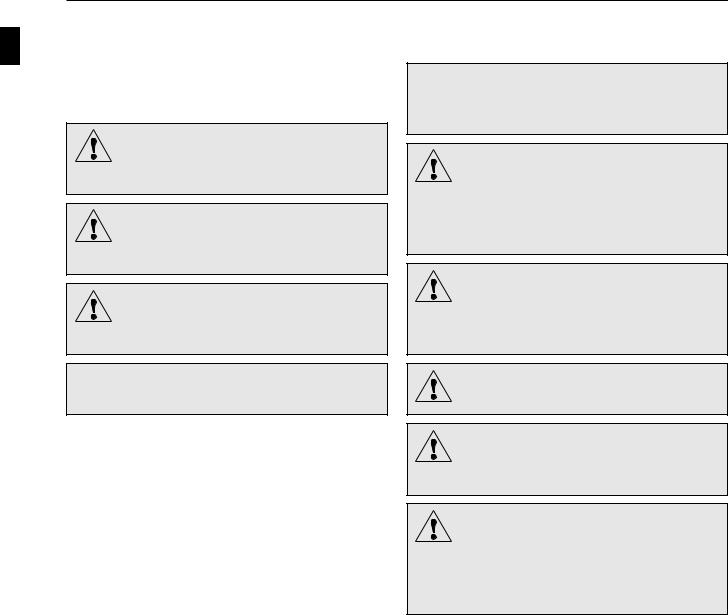
Introduction to CardioServ
1.2 For your Safety
The safety information given below is divided into the catego-
ries “Danger”, “Warning” and “Caution”.
indicates an imminently hazardous situation
which, if not avoided, will result in death or
Danger
serious injury.
indicates a potentially hazardous situation which,
if not avoided, could result in death or serious
Warning
injury.
indicates a potentially hazardous situation which,
if not avoided, may result in minor or moderate
Caution
injury and/or damage to the equipment.
provides application tips or other useful information to assure that you get the most from your equipment.
CardioServ is designed to comply with IEC 60601/ EN60601 requirements. It is Class I equipment and
has an internal power source.
CardioServ operates on line voltages between 95
and 240 Volts, 49 to 65 Hz. The mains plug
Warning
must be connected to an appropriate power supply with a non-fused earthed wire. The use of extension cords is not permitted.
Before putting the device into operation, visually
check all connecting cables and electrodes for signs
Warning
of damage. Damaged cables and electrodes must be replaced immediately, before use.
When disconnecting the device from the power
line, first remove the plug from the wall outlet.
Warning
Disconnect the device from the power line and
operate it on battery power, if the integrity of the
Warning
protective earth conductor is in doubt.
Set up the device in a location which affords
sufficient ventilation. The ventilation openings of
Caution
the device must not be obstructed. The ambient conditions specified in the “Technical Specifications” section must be ensured at all times.
8 |
CardioServ V 4.2 |
227 446 32-I |

Introduction to CardioServ
Devices intended for emergency application must
not be exposed to low temperatures during storage
Warning
and transport to avoid moisture condensation at the application site. Wait until all moisture has vaporized before using the device. Avoid using the defibrillator under conditions where prolonged exposure to or excessive contact with moisture can occur.
Before putting the defibrillator into operation,
make sure that the paddles and all connection
Danger
cables are dry.
CardioServ is an emergency device and must be
ready for operation at any time. For this reason,
Warning
the defibrillator battery must always be charged. This can be achieved by leaving the defibrillator connected to the power line when it is not needed in an environment where only battery operation is possible.
Possible explosion hazard if used in the presence
of concentrated oxygen.
Danger
CardioServ is suitable for application in a humid
environment provided the regulations concerning
Warning
drip-proof equipment of IEC 60601 are strictly observed. However, avoid defibrillation in a very moist or wet environment, unless absolutely necessary.
Use only the original GEMS IT batteries, as
these are designed for an extended temperature
Caution
range.
Magnetic and electrical fields are capable of
interfering with the proper performance of the
Warning
device. For this reason make sure that all external devices operated in the vicinity of the defibrillator comply with the relevant EMC requirements. X- ray equipment, MRI devices and radio systems are a possible source of interference as they may emit higher levels of electromagnetic radiation.
The defibrillator is designed for intracardiac application.
Devices may be connected to other devices or to
parts of systems only when it has been made
Warning
certain that there is no danger to the patient, the operators, or the environment as a result. In those instances where there is any element of doubt concerning the safety of connected devices, the user must contact the manufacturers concerned or other informed experts as to whether there is any possible danger to the patient, the operator, or the environment as a result of the proposed combination of devices. Standards IEC 60601-1-1/
EN 60601-1-1 must be complied with in all cases.
Set up the device so that the operator has a clear, unobstructed view of the front panel.
Liquids must not be allowed to enter the device.
Devices into which liquids have penetrated must
Warning
be immediately cleaned and checked by a service technician.
227 446 32-I |
CardioServ V 4.2 |
9 |
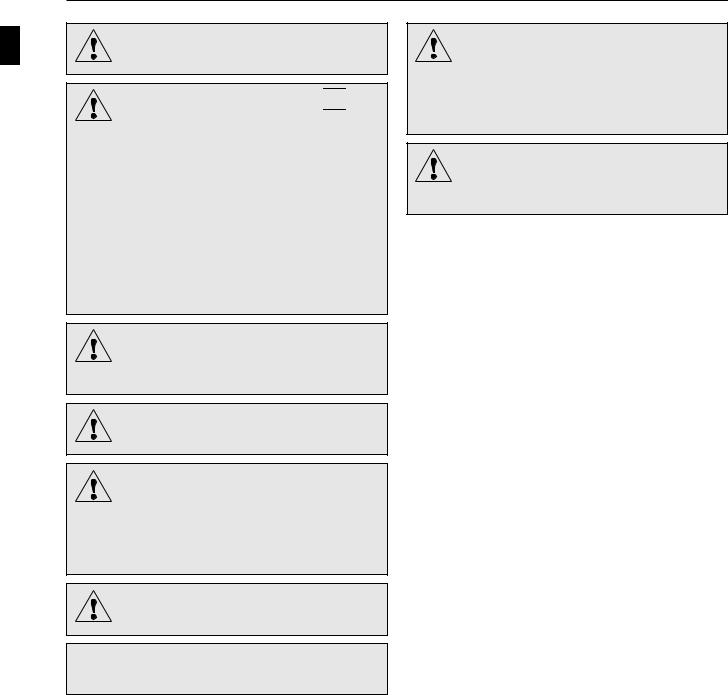
Introduction to CardioServ
Use only the original GEMS IT patient cables.
Do not connect other signal sources to the cables.
Danger
Patient signal inputs labelled with the 




symbol are protected against damage resulting
Caution
from defibrillation and electrocautery voltages. Nevertheless extreme care must be taken when devices which are directly connected to the patient remain applied during electrocautery or defibrillation. The distance between ECG electrodes should be at least 15 cm. If in doubt, disconnect the patient cable from the device while applying the defibrillation pulse or performing electrocautery.
For defibrillation of children use only the special
clip-on electrodes for children listed in section 15
Warning
“Order Information and Accessories”.
The full responsibility for the use of accessories
from other manufacturers lies with the user.
Warning
Check the device performance at regular intervals
(once a month), strictly following the instructions
Caution
given in section 3.2. Do not select high energy levels for test discharges with defibrillation electrodes shorted together.
For each defibrillation, verify that the selected
and the displayed/charged energy are identical.
Caution
CardioServ also operates on line power when the battery is depleted or missing.
At the end of its service life, CardioServ and its
accessories must be disposed of in compliance with
Caution
the special waste control regulations for electronic parts. If you have any questions in this matter, please contact GEMS IT GmbH.
Dispose of the packaging material, observing the
applicable waste-control regulations and keeping
Warning
it out of children’s reach.
Literature
Medical Device Directive
EN 60601-1/1990 + A 1: 1993 + A2: 1995: Medical electrical equipment. General requirements for safety
EN 60601-1-1/9.1994 + A1 12/1995: General requirements for safety. Requirements for the safety of medical electrical systems.
IEC Publication 513/1994: Fundamental aspects of safety standards for medical equipment.
ROY, O.Z.: Summary of cardiac fibrillation thresholds for 60-Hz currents and voltages applied directly to the heart. Med. & Biol. Engn. & Computing 18: 657...659 (1980).
10 |
CardioServ V 4.2 |
227 446 32-I |
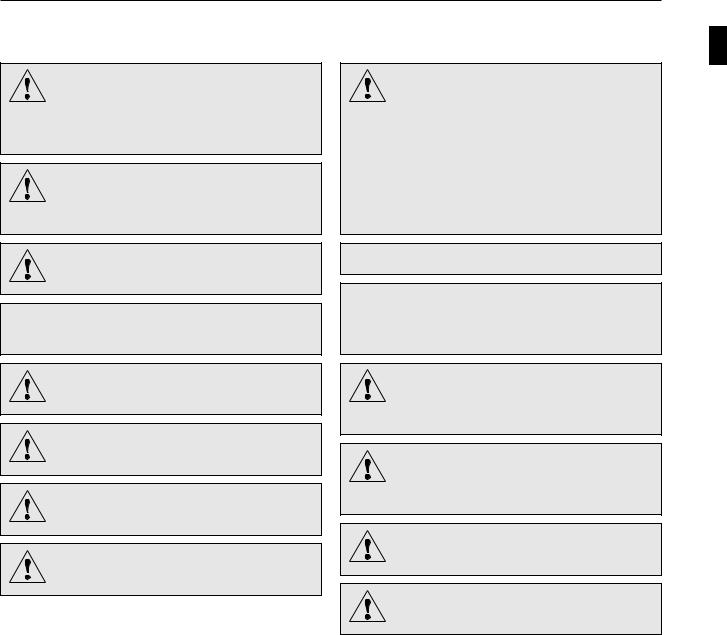
Introduction to CardioServ
General points to note when handling a defibrillator
Electromedical equipment such as the CardioServ
defibrillator must only be handled by persons who
Warning
are trained in the use of such equipment and are capable of applying it properly.
Before using the equipment, the operator must
ascertain that it is in correct working order and
Warning
operating condition.
The defibrillator paddles must be clean and dry.
Danger
The person carrying out the defibrillation should have at least one assistant.
The operator must be trained in the use of the
defibrillator.
Warning
All assistants must be briefed regarding the
preparations for and execution of defibrillation.
Warning
All tasks must be assigned clearly.
Warning
Defibrillating a patient with normal heart
rhythm may induce ventricular fibrillation.
Danger
Position the patient flat on a hard, dry surface
where the patient is electrically insulated. The
Caution
patient must not be allowed to come into contact with metal parts, e.g., bed or litter, in order to prevent unwanted pathways for the defibrillation current which endanger the assistants. For the same reason, do not place the patient on wet ground (rain, accident in swimming pool).
Have a pacemaker at hand, if possible.
Should cardiac arrest occur or be imminent during preparations for defibrillation, administer heart
massage and artificial respiration (CPR).
Do not allow the defibrillator paddles to come
into contact with other electrodes or metal parts
Danger
which are in contact with the patient.
Transducers and instruments that are not defi-
brillation-proof must be disconnected from the
Caution
patient.
Interrupt heart massage and artificial respiration
immediately before triggering the shock.
Danger
Immediately before triggering the shock discon-
nect tubes and have assistants step back.
Caution
227 446 32-I |
CardioServ V 4.2 |
11 |
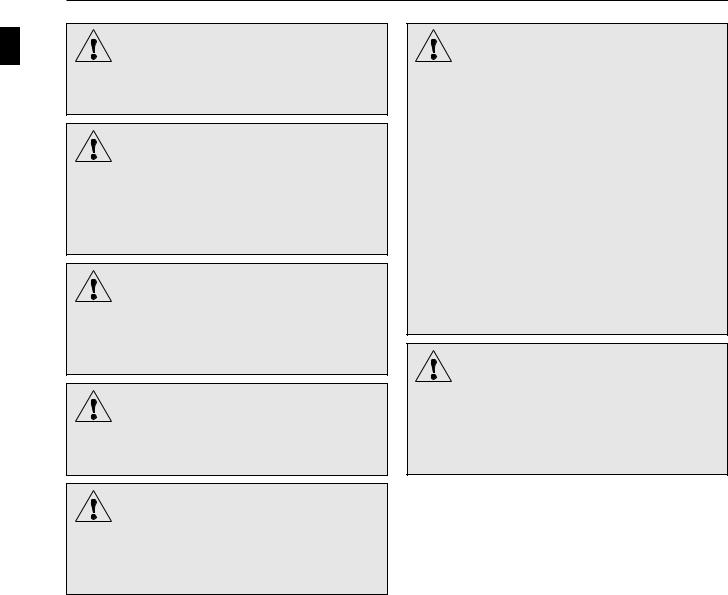
Introduction to CardioServ
The patient’s chest must be dry, as moisture causes
unwanted pathways for the defibrillation current.
Caution
Therefore, when using flammable skin cleansing agents, wait until they have completely dried.
Possible explosion hazard if used in the presence
of concentrated oxygen, flammable substances
Danger
(gasoline) or anesthetic agents. Oxygenation in the vicinity of the defibrillation paddles must be strictly avoided; if necessary, interrupt oxygen supply while defibrillating the patient.
To prevent sparking
– the electrodes should make full contact with
Warning
the body
–the electrodes should be pressed firmly onto the thorax.
Do not deliver shocks into open air. High voltage
may briefly be present at the unprotected paddle
Caution
surfaces as a result and endanger the persons present.
When defibrillating children it is especially
important to verify that the paddles make full
Caution
contact with the body surface. This is to be observed also when using the clip-on electrodes for children (Part No. 303 439 95).
Defibrillating a patient who has an implanted
pacemaker is likely to impair the pacemaker
Warning
function or cause damage to the pacemaker. Therefore, the following should be observed:
–Select the smallest energy level possible for the application.
–Do not apply the defibrillation paddles in the vicinity of the pacemaker electrodes.
–The availability of an external pacemaker is of utmost importance in this case.
–After the defibrillation the working order of the implanted pacemaker should be checked immediately.
Also be aware that children require less energy for
a successful defibrillation than adults. For the
Warning
first defibrillation pulse delivered to babies and toddlers, select an energy level of 2 joules/kg body weight. For subsequent shocks, increase the energy up to 4 joules/kg.
12 |
CardioServ V 4.2 |
227 446 32-I |

Controls and Indicators
2. Controls and Indicators
This section describes the CardioServ operating controls and indicators and explains their function.
When operating elements in this manual are identified with a reference number in parentheses, this number refers to Figure 2-1 in this section.
You will also find an explanation of all signs and symbols used on the CardioServ defibrillator.
227 446 32-I |
CardioServ V 4.2 |
13 |
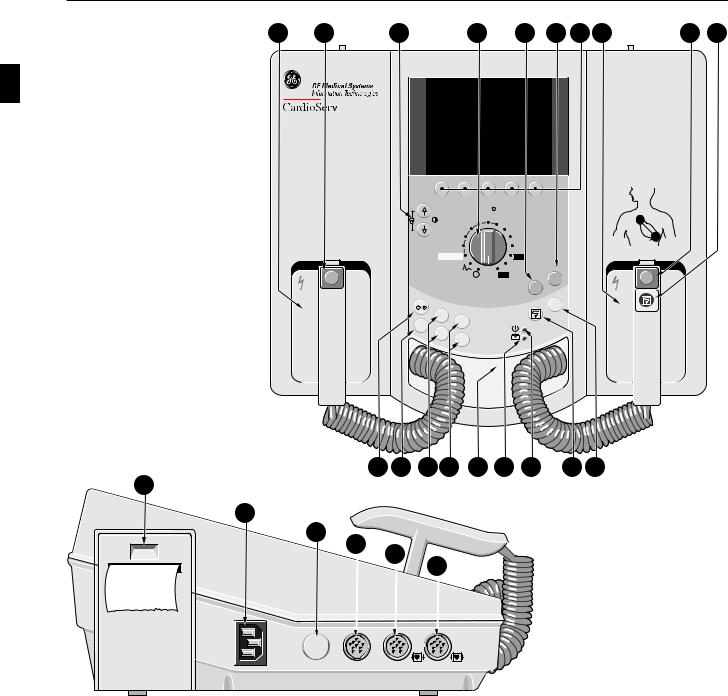
|
Controls and Indicators |
|
|
|
|
|
|
|
|
|
|||||||
1 |
2 |
3 |
|
|
|
|
|
|
4 |
|
|
5 |
6 |
7 |
1 |
8 |
9 |
|
|
|
|
|
|
|
|
|
|
|
|
|
|
|
1 |
Select energy |
|
|
|
|
|
|
|
|
|
|
|
|
|
|
|
|
|
Apply electrode cream to both paddles |
|
|
|
|
|
|
|
|
|
|
|
|
|
|
|
|
2 |
Charge defibrillator |
|
|
|
|
|
|
|
|
|
|
|
|
|
|
|
|
|
Press charge button on apex paddle |
|
|
|
|
|
|
|
|
|
|
|
|
|
|
|
|
|
(on the device, when using adhesive |
|
|
|
|
|
|
|
|
|
|
|
|
|
|
|
|
|
or internal electrodes) |
|
|
|
|
|
|
|
|
|
|
|
|
|
|
|
|
3 |
Deliver shock |
|
|
|
|
|
|
|
|
|
|
|
|
|
|
|
|
|
Press buttons on both paddles simul- |
|
|
|
|
|
|
|
|
|
|
|
|
|
|
|
|
|
taneously (on the device, when using |
|
|
|
|
|
|
|
|
|
|
|
|
|
|
|
|
|
adhesive or internal electrodes) |
|
|
|
|
|
|
|
|
|
|
J (50 |
) |
|
|
|
|
|
|
|
|
|
|
|
|
|
|
|
|
10 |
20 |
30 |
|
|
|
|
|
|
|
|
|
|
|
|
|
|
|
|
|
|
|
|
|
|
||
|
|
|
|
|
|
|
|
|
7 |
|
50 |
|
|
|
|
|
|
|
|
|
|
|
|
|
|
|
5 |
|
|
100 |
|
|
|
|
|
|
|
|
|
|
|
|
|
2 |
|
|
150 |
|
|
|
APEX |
|
|
|
|
|
|
|
|
|
|
|
|
|
|
|
|
|
|||
|
|
|
|
|
|
|
|
2 |
|
|
200 |
|
|
|
|
|
|
|
|
|
|
|
Autosequence |
|
|
|
|
|
|
|
|
||||
|
|
|
|
|
|
|
|
|
|
|
300 |
|
|
|
2 |
|
|
|
|
|
|
|
|
|
|
|
|
|
360 |
|
|
|
|
|
|
|
Shock |
|
|
|
|
|
|
|
|
|
|
|
|
|
Charge |
|
|
|
|
|
|
|
|
|
|
|
|
|
|
Shock |
|
|
Charge |
|
|
|
|
|
|
|
|
|
|
|
|
|
|
|
|
|
Shock |
|
|
|
3 |
|
|
|
|
|
|
|
|
|
|
Charge |
|
|
|
3 |
|
|
|
|
Pa |
|
|
|
|
|
|
|
|
Shock |
|
|
|
|
|
|
|
|
|
|
|
|
|
|
|
|
|
|
|
|
|
|
|
|
|
|
ce |
|
|
|
|
|
|
|
|
|
|
|
|
|
|
|
|
|
|
m |
|
|
|
|
|
|
|
|
|
|
|
|
|
|
|
|
|
ak |
|
|
|
|
|
|
|
Sync |
|
|
|
|
|
|
STERNUM |
|
|
|
er |
Sti |
|
|
|
|
|
|
|
|
|
||
|
|
|
|
+ |
|
mul |
ateur |
|
|
|
|
|
|
APEX |
|
||
|
|
|
|
|
P/min |
|
|
+ |
|
|
|
|
|
|
|
|
|
|
|
|
Dem |
|
|
|
|
mA |
|
|
|
|
|
|
|
|
|
|
|
|
Fix |
|
P/min |
|
|
|
|
|
|
|
|
|
|
|
|
|
|
|
|
|
|
|
|
|
- + |
|
|
|
|
|
|||
|
|
|
|
|
– |
|
|
mA |
|
|
|
|
|
|
|||
|
|
|
|
|
|
|
|
|
– |
|
|
|
|
|
|
|
|
|
|
18 17 |
16 15 |
|
14 |
13 |
12 |
|
11 10 |
|
|
||||||
19 |
|
|
|
|
|
|
|
|
|
|
|
|
|
|
|
|
|
20 |
|
|
|
|
|
|
|
|
|
|
|
|
|
|
|
|
|
|
21 |
|
|
|
|
|
|
|
|
|
|
|
|
|
|
|
|
|
22 |
23 |
|
|
|
|
|
|
|
|
|
|
|
|
|
|
|
|
|
|
24 |
|
|
|
|
|
|
|
|
|
|
|
|||
|
|
|
|
|
|
|
|
|
|
|
|
|
|
|
|||
|
Option |
SpO2 |
|
EKG |
|
|
|
|
|
|
|
|
|
|
|
|
|
|
|
|
|
|
|
|
|
|
|
|
|
|
|
|
|
|
|
Figure 2-1. Controls and indicators of CardioServ |
|
|
|
|
|
|
|
|
|
|
|
|
|
|
|
|
|
14 |
CardioServ V 4.2 |
|
|
|
|
|
|
|
|
|
|
227 446 32-I |
|||||

Controls and Indicators
1Defibrillator paddles
2 Shock button to trigger the defibrillation shock – together
3
with button (8)
3
 keys to adjust the LCD contrast. Press both keys simultaneously to obtain a screen copy.
keys to adjust the LCD contrast. Press both keys simultaneously to obtain a screen copy.
4Energy selector, on/off switch
5ChargeShock key to charge the unit (manual mode) and to
trigger the defibrillation shock – together with key (6). This key assumes the function of button (8) when internal paddles or adhesive electrodes are used.
6Shock key to trigger the defibrillation shock – together
with key (5). This key assumes the function of button (2) when internal paddles or adhesive electrodes are used.
7Five selection keys F1 to F5 whose functions change with the menu displayed. The respective key functions are indicated by symbols or labels in the bottom line on the LCD. From the main menu, that appears on power up, you can access submenus which, in turn, allow the selection of further options. The back function returns you to the next higher menu level. The main menu reappears automatically if you do not depress any of the keys for about 30 seconds.
8 |
|
2 |
button to charge the unit (manual mode) and |
Charge |
|
||
Shock |
|
3
trigger the defibrillation shock – together with button (2)
9 button to start and stop the recorder.
button to start and stop the recorder.
10 Sync key to switch to the synchronized operating mode (section 5 “Cardioversion”)
11 key to start and stop the recorder. This key assumes the function of button (9) when internal paddles or
key to start and stop the recorder. This key assumes the function of button (9) when internal paddles or
adhesive electrodes are used.
12Green indicator  is lit when the defibrillator operates on line power.
is lit when the defibrillator operates on line power.
13Yellow indicator - + is lit when the defibrillator battery is being charged.
+ is lit when the defibrillator battery is being charged.
14Connection for defibrillator paddles
(controls 15 to 18 only on models with pacemaker)
15 |
Keys |
+ |
- |
to adjust the pacer output |
mA |
||||
|
|
|
mA |
|
16 |
Keys |
+ |
- |
to adjust pacer rate |
P/min |
||||
|
|
|
P/min |
|
17Pacing mode selection key DemFix (demand/fixed rate)
18Key  to enable and disable the pacemaker
to enable and disable the pacemaker
19Aperture to open the paper compartment
20Connector for power cord
21Unassigned
221-Volt ECG output
23Connector for SpO2 sensor
24Connector for patient cable (ECG signal input)
227 446 32-I |
CardioServ V 4.2 |
15 |

Controls and Indicators
|
Explanation of the signs and symbols used on the defibrillator |
|
|
|
|
|
||||
|
|
|
|
|
Type CF equipment with highly insulated patient |
|
|
|
|
Standby or preparatory state only for a part of the |
|
|
|
|
|
|
|
|
|
||
|
|
|
|
|
|
|
|
|
||
|
|
|
|
|
connections, suitable for intracardiac application, |
|
|
|
|
equipment |
|
|
|
|
|
|
|
|
|
||
|
|
|
|
|
|
|
|
|||
|
|
|
|
|
connections defibrillation-proof. |
|
|
|
|
|
|
|
|
|
|
|
|
|
|
|
On, only for a part of the equipment |
|
|
|
|
|
Type CF equipment with highly insulated patient |
|
|
|||
|
|
|
|
|
|
|||||
|
|
|
|
|
connections, suitable for intracardiac application, |
Refer to Operator’s Manual |
||||
|
|
|
|
|
|
|
|
|
||
|
|
|
|
|
connections not defibrillation-proof. |
|
|
|
|
|
|
|
|
|
|
|
|
|
|
|
Hardcopy of screen image |
|
|
|
|
|
|
|
|
|
|
|
Standby mode (for line-power operation)
|
|
Power off |
- |
+ |
Battery charging |
|
|
Recorder start |
This symbol indicates that the waste of electrical and electronic equipment must not be disposed as unsorted municipal waste and must be collected separately. Please contact an authorized representative of the manufacturer for information concerning the decommissioning of your equipment.
ECG signal
Contrast
Direction indicator
Signal output
Audible alarm on/off
High voltage
16 |
CardioServ V 4.2 |
227 446 32-I |

Setting Up CardioServ and Testing Its Performance
3.Setting Up CardioServ and Testing Its Performance
In this section you will find information about
–putting CardioServ into operation
–connecting CardioServ to the 12-Volt power supply of an ambulance vehicle
–customizing the CardioServ settings to suit your personal requirements
–testing the CardioServ performance before using it on a patient
227 446 32-I |
CardioServ V 4.2 |
17 |

Setting Up CardioServ and Testing Its Performance
3.1 Setting Up CardioServ
The defibrillator is a high-voltage electrotherapy
device and must be handled by qualified person-
Danger
nel only. Improper use of this device can endanger life. Do not fail to observe the information given in this manual and only entrust the device to the hands of trained persons.
Check the electrodes and their leads for signs of damage every time before you use the defibrillator. In particular, make a close visual inspection of the insulation. Replace internal electrodes or the contact inserts when you detect signs of mechanical damage.
CardioServ operates on:
–line power (95 to 240 V, 49 to 65 Hz)
–battery power (rechargeable batteries), i.e., independent of the power line
–12-Volt power supplied from the emergency vehicle (with optional defibrillator mounting system)
* Use the power cord to connect the defibrillator to the power line (Figure 3-1).
Figure 3-1. Power input
18 |
CardioServ V 4.2 |
227 446 32-I |

Setting Up CardioServ and Testing Its Performance
ema
m x
|
|
360 |
|
|
Shock |
|
|
Charge |
|
|
Shock |
k |
|
|
er |
|
|
Sti |
mu |
Sync |
+ |
lateur |
|
|
|
|
P/min |
+ |
|
|
mA |
|
P/min |
|
|
|
mA |
- + |
*Check that the green indicator is lit (Figure 3-2).
Figure 3-2. Green indicator (indicating that defibrillator is supplied from the power line)
|
|
|
|
|
|
* |
Check that the battery is in place (Figure 3-3). |
|||||||||
|
|
|
|
|
|
|
|
|
|
|
Pull back the catch on the underside of the device to remove |
|||||
|
|
|
|
|
|
|
|
|
|
|
the battery. When inserting it, make sure that it clicks prop- |
|||||
|
|
|
|
|
|
|
|
|
|
|
erly into place. |
|||||
|
|
|
|
|
|
|
|
|
|
|
When a battery is inserted, the yellow indicator |
|
|
|
starts |
|
|
|
|
|
|
|
- |
+ |
|||||||||
|
|
|
|
|
|
|
|
|
|
|
flashing as soon as the defibrillator is connected to the power |
|||||
|
|
|
|
|
|
|
|
|
|
|
line (to indicate that the battery is charging). The battery is |
|||||
|
|
|
|
|
|
|
|
|
|
|
fully charged after 16 hours and the indicator is continuously |
|||||
Figure 3-3. Inserting the battery |
|
|
|
|
|
lit. |
|
|
|
|
|
|||||
|
|
|
|
|
|
|
|
|
|
|
||||||
|
|
|
|
|
|
* |
Check that the supply of chart paper is sufficient (Figure |
|||||||||
|
|
|
|
|
|
|
|
|
|
|
|
3-4). A stripe marks the last 3 meters of the roll. |
||||
|
|
|
|
|
|
|
|
|
|
|
|
|
|
|
|
|
|
|
|
|
|
|
|
|
|
|
|
|
|
|
|
|
|
|
|
|
|
|
|
|
|
|
|
|
|
|
|
|
|
|
|
|
|
|
|
|
|
|
|
|
|
|
|
|
|
|
|
|
|
|
|
|
|
|
|
|
|
|
|
|
|
|
|
|
|
|
|
|
|
|
|
|
|
|
|
|
|
|
|
|
|
|
|
|
|
|
|
|
|
|
|
|
|
|
|
|
|
|
|
|
|
|
|
|
|
|
|
|
|
|
|
|
|
|
|
|
|
|
|
|
|
|
|
|
|
|
|
|
|
|
|
|
|
|
|
|
|
|
|
|
|
|
|
|
|
|
|
|
|
|
|
|
|
|
|
|
|
|
|
|
|
|
|
|
|
|
|
|
|
|
|
|
|
|
|
|
|
|
|
|
|
|
|
|
|
|
|
|
|
|
|
|
|
|
|
|
|
|
|
|
|
|
|
|
|
|
|
|
|
|
|
|
|
|
|
|
|
|
|
|
|
|
|
|
|
|
|
|
|
|
|
|
|
|
|
|
|
|
|
|
|
|
|
|
|
|
|
|
|
|
|
Figure 3-4. Recording strip
227 446 32-I |
CardioServ V 4.2 |
19 |

Setting Up CardioServ and Testing Its Performance
-
+
-
+
|
|
- |
|
|
|
+ |
|
|
>9 |
T |
|
> |
est |
||
5 |
|
||
< |
80 |
% |
|
% |
|
|
|
80 |
|
|
|
% |
|
|
|
|
|
S |
Te |
|
|
st |
|
|
|
|
tart |
Figure 3-5. Accu Service Unit
We recommend our Accu Service Unit for optimal care of the batteries. It prolongs the batteries’ service
life and guarantees their operational readiness at all times.
A NiCd battery should not be charged while
located in direct sunlight, over a radiator, in cold
Warning
storage, or in other temperature extremes (not below 5 °C). When the instrument is charging, ambient temperatures exceeding 40 °C may adversely affect battery capacity and life.
Power Supply From Emergency Vehicles
A qualified technician can be called in to connect the
CardioServ to the 12-Volt supply of an emergency vehicle. The following points must be noted:
–The negative terminal of the ambulance power supply system must be connected to the ambulance chassis for grounding.
–The positive lead of the ambulance power supply system intended to supply the current must be protected with a 10-A fuse.
–Use only the defibrillator mounting system listed in section 15 “Order Information and Accessories” or the external charging unit, if your CardioServ has been modified accordingly.
Check that the contacts for power supply from the defibrillator mounting system on the underside of
CardioServ (next to battery) are clean. Do not damage them in any way.
Important Information on Battery-Power Operation
Rechargeable batteries require special maintenance and continued checks to assure they function in emergency situations. It is normal for batteries of this type to selfdischarge when not in use.
The battery charges automatically when CardioServ is connected to the power line (yellow indicator (13) flashes).
20 |
CardioServ V 4.2 |
227 446 32-I |

Setting Up CardioServ and Testing Its Performance
In order to ensure its functioning as an emergency device, the |
Inserting CardioServ In Its Softcase |
|
defibrillator should not be disconnected from the power line |
|
|
for more than 48 hours. |
* |
Open both zips on the CardioServ softcase. |
A fully charged battery supplies power for 35 defibrillation shocks of 360 joules or 2 hours of monitoring (or 1.2 hours of monitoring if the CardioServ unit has pacemaker and SpO2 option). It takes 16 hours to charge a depleted battery.
Proceed as follows to test the battery charge level:
–Disconnect CardioServ from the power line.
–Trigger a test discharge of 360 joules (see section 3.2 “Testing the Defibrillator Performance”).
–If you are not prompted to charge the battery, the charge level should be sufficient for at least 5 more 360-joule shocks.
Monthly battery maintenance and checks:
1.Disconnect CardioServ from the power line and
discharge fully charged battery in the monitoring mode. To do so, set energy selector switch to  , (SpO2 sensor not connected) and wait until device switches off.
, (SpO2 sensor not connected) and wait until device switches off.
2.Check how long it takes before battery is depleted. If the time is less than 1.8 hours, the battery is too old or improperly maintained and must be replaced.
3.Recharge the battery. This will take 16 hours.
For easy, convenient care and maintenance of the batteries, use our “Accu Service Unit”.
*Undo the two Velcro strips on the front of the softcase.
*Open the Velcro flap located in front of the CardioServ printer.
*Place the softcase on the small base, so that the softcase is positioned as though you were carrying it.
*Disconnect the paddles on the CardioServ and remove them.
*Hold all the opened up parts of the softcase to the side and put the CardioServ into the softcase.
*Pull the softcase by the two Velcro strips on the black base into position, ensuring that the feet of the CardioServ are in the cut-out openings provided.
*Close the two front Velcro strips as well as the flap in front of the printer at the side.
*Close the zips.
*If the individual cut-out openings for the external connections, paddles or feet are not correctly positioned, pull the material at this point into the right shape.
*Reconnect the paddles and put them back into the CardioServ recesses.
227 446 32-I |
CardioServ V 4.2 |
21 |

Setting Up CardioServ and Testing Its Performance
Customizing the defibrillator settings
Further steps that can be taken while setting up the defibrillator include customizing the device functions. This allows you to select defibrillator default settings which suit your personal preferences. CardioServ saves these configured settings and reactivates them automatically every time you switch the defibrillator on. The following chart shows the factory settings of all parameters and the optional adjustments.
Refer to section 11 “The Defaults Menu” for a detailed explanation of how to customize the CardioServ, including the language selection (available languages are English, French, German, Italian, Portuguese, Russian, Spanish and Swedish).
Parameter |
Description |
Factory Setting |
Adjustment range |
Customized settings |
HR Limits |
HR alarm limits |
40/160 |
off 15 to 300 off |
|
Sensitivity |
ECGsignal size |
1 |
.5, 1, 2 cm/mV |
|
|
|
|
|
|
Lead |
|
1 |
all standard leads + paddles |
|
Autoseq. |
autosequencing energy levels |
200 J, 200 J, 360 J |
150 J, 200 J, 300 J, 360 J, |
|
|
|
|
|
|
SpO2 Limits |
alarm limits |
90/off |
off 15 to 100 off |
|
C-Lock |
ECG-synchronized SpO2 measurement |
off |
on/off |
|
SpO2 Int. Time |
SpO2 integration time |
8 s |
4 s, 8 s, 12 s (not recommended) |
|
Lead Fail Alarm |
|
off |
off / 30 s |
|
|
|
|
|
|
QRS Beep |
|
off |
on/off |
|
Alarm Tone |
|
off |
on/off |
|
|
|
|
|
|
Alarm Printout |
autom. recorder start |
off |
on/off |
|
Shock Printout |
autom. recorder start |
on |
on/off |
|
Cont. Printout |
recorder stop upon manual start |
off |
on/off |
|
Pacemaker |
pulse rate |
60 BPM |
15 to 150 P/min |
|
|
|
|
|
|
Display |
|
normal |
normal/reversed |
|
|
|
|
|
|
Display |
|
0 degrees |
0 degrees/180 degrees |
|
Volume |
volume of all audio signals |
loud |
loud/low |
|
AC Filter |
|
50 Hz |
50 Hz / 60 Hz / off |
|
Muscle Filter |
elimination of motion artifact |
on |
on/off |
|
Date/Time |
|
|
|
|
Date Format |
|
DD:MM:YYYY |
DD:MM:YYYY/MM:DD:YYYY |
|
Language |
|
German |
English, French, German, |
|
|
|
|
Italian, Portuguese, Russian, |
|
|
|
|
Spanish, Swedish |
|
User |
free text or name (40 characters) |
|
|
|
Factory default |
reestablish factory settings |
off |
on/off |
|
|
|
|
|
|
Table 1
22 |
CardioServ V 4.2 |
227 446 32-I |
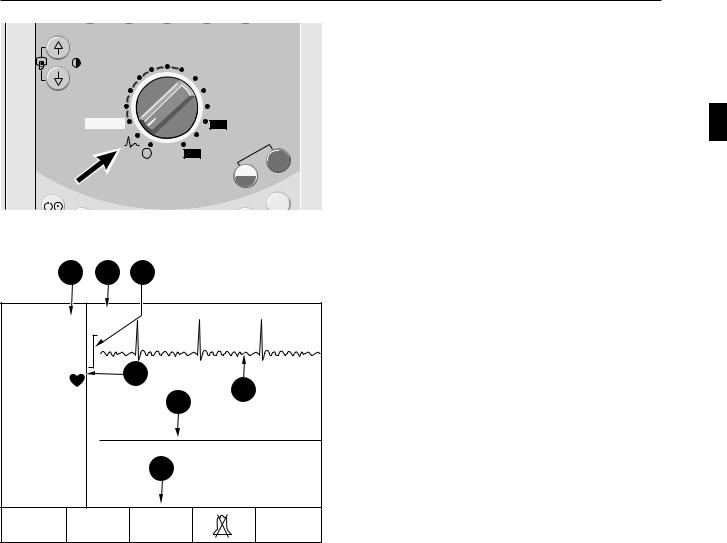
Setting Up CardioServ and Testing Its Performance
|
J (50 Ω) |
||
|
10 |
20 |
30 |
|
|
||
|
7 |
|
50 |
|
5 |
|
100 |
|
2 |
|
150 |
|
Autosequence |
|
200 |
|
|
|
300 |
|
|
|
360 |
|
|
|
Shock |
|
|
|
Charge |
P |
|
|
Shock |
a |
|
|
|
|
c |
|
|
|
e |
|
|
|
m |
|
|
|
a |
|
|
|
k |
|
|
|
er |
|
|
|
Stimula |
|
Sync |
Figure 3-6. Switching on CardioServ
|
a b c |
|
|
0 |
Paddle |
|
|
|
160 |
BPM |
|
140 |
ECG |
d |
HR Alarm |
||
|
|
|
e
f
g
ECG |
SpO2 Freeze |
Next |
Menu |
Figure 3-7. CardioServ main display
aheart/pulse-rate reading with alarm limits
bECG signal source
c1-mV calibration pulse
dalarm message, QRS blip
esignal trace, channel 1
fsignal trace, channel 2
gmenu
3.2Testing the Defibrillator Performance
On power up CardioServ runs an automatic selftest. Any malfunctions identified during this test result in an error message displayed on the LCD (refer to section 12 “Error Indications and Messages”). As a further performance test a trial defibrillation can be triggered.
The energy selector is used to switch CardioServ on and off. Once you have become familiar with CardioServ you can thus switch on the defibrillator and select the required energy in one single operation.
*Set the energy selector to the  position. No energy will be stored in this position of the switch.
position. No energy will be stored in this position of the switch.
The defibrillator beeps and displays a checkered pattern (LCD performance test). Next the main display appears (Figure 3-7).
The “Paddle” message (b, Figure 3-7) indicates that no patient cable is connected and that the ECG signal is acquired via the defib paddles. Upon connection of the patient cable the selected ECG lead is displayed here. CardioServ is now ready for operation.
227 446 32-I |
CardioServ V 4.2 |
23 |

Setting Up CardioServ and Testing Its Performance
Do not trigger more than 5 consecutive test
discharges (or internal safety discharges) within
Caution
15 minutes at max. energy setting.
Test Discharge
A test discharge can be triggered to check the defibrillator discharge circuit. For this test the stored energy is discharged into the device via two contacts in the paddle compartments.
|
Paddle |
|
|
|
0 |
|
|
160 |
BPM |
|
|
140 |
ECG |
|
|
HR Alarm |
|
|
|
|
|
|
360 J |
|
|
|
Next |
ECG |
SpO2 |
Freeze |
Menu |
Figure 3-8. Display of selected energy
*Set the energy selector to 360 joules (50 joules, if internal electrodes are connected). The display first shows the selected energy (Figure 3-8).
* |
Press the |
2 |
button on the paddle to charge the unit. |
Charge |
|||
3 Shock |
|||
|
(Press the ChargeShock |
key on the defibrillator, when using |
|
internal electrodes.)
You may now watch the defibrillator charging.
*When the selected energy level has been reached,
CardioServ beeps and the stored energy is displayed (Figure 3-9).
Do not deliver shocks into open air. High voltage
may briefly be present at the unprotected paddle
Caution
surfaces as a result and endanger the persons present.
*Trigger the defibrillation pulse within the next 30 seconds. To do so, simultaneously press the buttons on
both paddles (or press the two ChargeShock Shock keys on the defibrillator, when using internal electrodes).
If more than 5% of the available energy are lost before the defibrillation pulse is triggered, CardioServ recharges until the required energy level is reached.
24 |
CardioServ V 4.2 |
227 446 32-I |

Setting Up CardioServ and Testing Its Performance
|
Paddle |
|
|
|
0 |
|
|
160 |
BPM |
|
|
140 |
ECG |
|
|
HR Alarm |
|
|
|
|
|
Energy |
|
|
|
available |
360 J |
|
|
|
|
|
|
|
Next |
ECG |
SpO2 |
Freeze |
Menu |
Figure 3-9. Display of available energy
If you do not trigger the defibrillation pulse within 30 seconds, an internal safety discharge is initiated
automatically.
The message “Energy high” or “Energy low”
indicates that CardioServ needs to be repaired.
Caution
If, in spite of this energy storage problem, the device has to be employed, it will display the message “Self-test failed. Charge Energy Error” upon power up. In this situation press one of the function keys and proceed as usual.
After defibrillation, the beeping sound stops, and the energy actually delivered into a 50-ohm resistance is displayed for 10 seconds in place of the stored energy (Figure 3-9). The delivered energy must not deviate more than ±15% or
±4 joules (whichever is greater) from the selected value. A recording is initiated at the same time (16-second strip).
Should the discharge circuit be interrupted (paddles not properly placed on contacts in the compartments, defective lead), an internal safety discharge is initiated 200 ms after the defibrillation shock has been triggered. In this case the “delivered energy” is “0”.
If the defibrillator cannot store the selected energy so that selected and stored energy values differ, the LCD shows the message “Energy high” or “Energy low”. The defibrillation pulse can be triggeed all the same.
*Switch off CardioServ (set energy selector to  ).
).
Testing the Pacemaker Performance
The performance of the pacemaker can be tested with a commercially available pacemaker tester (e.g. CS300 Simulator from GEMS IT, part no. 417 983-001).
Performance Test
Caution |
Test the defibrillator performance once a week: |
|
|
|
test 1 – defibrillator connected to mains, battery |
|
removed, |
|
test 2 – defibrillator disconnected from mains, |
|
battery inserted |
227 446 32-I |
CardioServ V 4.2 |
25 |

Setting Up CardioServ and Testing Its Performance
For your notes
|
|
|
|
26 |
CardioServ V 4.2 |
227 446 32-I |
|

Non-Synchronized Defibrillation
4. Non-Synchronized Defibrillation
This section describes first how to perform a non-synchro- nized defibrillation, using the standard defibrillation paddles. The subsequent explanations refer to the use of internal and disposable adhesive electrodes.
At the end of this section you will find a summary of all necessary operating steps (brief operating instructions).
227 446 32-I |
CardioServ V 4.2 |
27 |
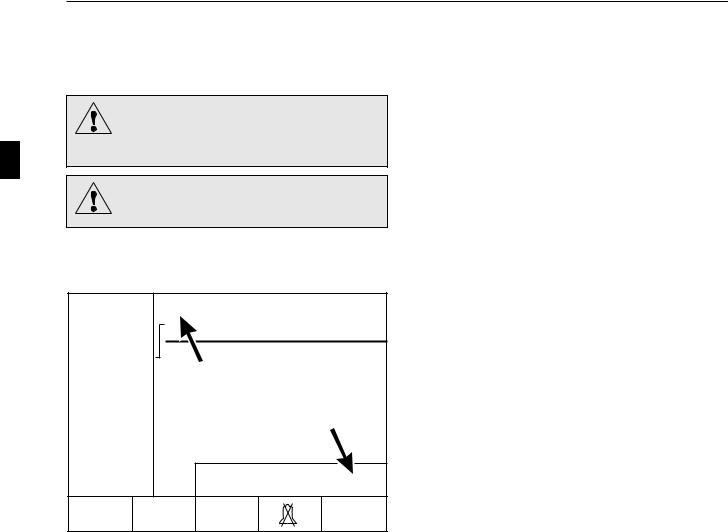
Non-Synchronized Defibrillation
The information given in section 1.2 must be
observed without fail to ensure safe and reliable
Warning
application of the device.
Always switch off CardioServ before exchanging
the defibrillation paddles.
Danger
4.1Defibrillation with Standard Electrodes
The energy selector can be set to the autosequence position, where the defibrillator automatically sequences the preset energy levels. The preset factory default setting is the sequence recommended by AHA/ERC (200 J, 200 J, 360 J). The factory default values can be changed from the defaults menu. You can choose among 150 J, 200 J, 300 J and 360 J.
*Set the energy selector (4) to “Autosequence” or to the required energy value (this turns on CardioServ).
|
0 |
Paddle |
|
|
|
|
|
|
|
160 |
BPM |
|
|
|
140 |
ECG |
|
|
|
HR Alarm |
|
|
|
|
|
|
|
|
200 J |
ECG |
SpO2 |
|
Next |
|
Freeze |
Menu |
|||
Figure 4-1. Main display, indication of ECG lead, manual
operation and selected energy
The defibrillator beeps and displays a checkered pattern (LCD performance test). Next the main display appears (Figure 4-1). When a patient cable is connected the selected ECG lead is displayed (selectable).
*Check that the energy selector locks in on the correct position and that the display shows the selected energy (Figure 4-1).
The energy depends on the defibrillation mode, on the patient’s age and constitution. In external application the thickness of the tissue is also a factor which influences the amount of energy required.
The energy necessary for successful ventricular defibrillation without damaging the myocardium has for many years been a matter of scientific controversy. The manufacturer is therefore not able to give any recommendations.
28 |
CardioServ V 4.2 |
227 446 32-I |

Non-Synchronized Defibrillation
Figure 4-2. Removing the paddles
Do not apply the paddles over
– sternum or clavicle
Warning
–nipples
–implanted pacemaker or defibrillator.
3
 STERNUM
STERNUM
3 |
Charge |
2 |
|
APEX
Figure 4-3. Paddle application points
In emergency situations AHA recommends for adult patients
1.defibrillation with 200 joules; if unsuccessful, repeat
2.defibrillation with 200 joules; if unsuccessful, repeat
3.defibrillation with max. energy setting (360 joules).
Please note that children require less energy for successful ventricular defibrillation than adults. For the first defibrillation pulse delivered to babies and small children, select an energy level of 2 joules/kg body weight. For subsequent shocks, the energy may be increased to 4 joules/kg.
In compliance with IEC requirements the energy adjusted on this defibrillator is not the stored energy, but the energy released into an external resistance of 50 ohms (patient resistance + electrode-to-skin contact resistance). The energy selector is labelled accordingly.
*Remove the paddles from their compartments (as shown in Figure 4-2). Carefully dry the electrodes, if they are wet. The handles, in particular, must be completely dry. Apply an ample amount of electrode cream to each paddle.
*Apply the electrodes to the patient’s thorax so that the greatest possible amount of energy flows through the myocardium (the imaginary connecting line between the two electrode centers should be identical with the cardiac median line; Figure 4-3).
*Press paddles firmly down onto the patient’s thorax..
227 446 32-I |
CardioServ V 4.2 |
29 |
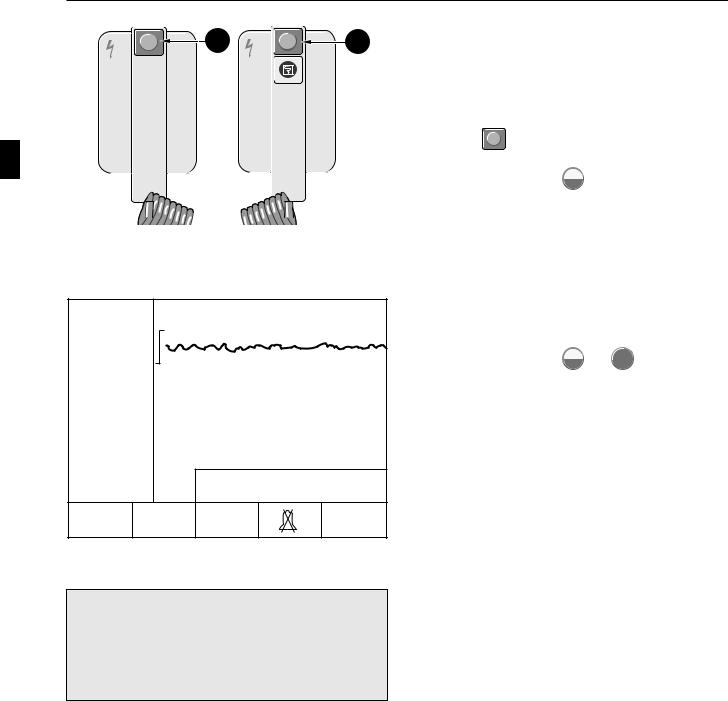
Non-Synchronized Defibrillation
3 |
2 |
3 |
2 |
8 |
|||
Shock |
|
Charge |
|
|
Charge |
|
|
|
|
Shock |
|
STERNUM |
|
APEX |
|
Figure 4-4. Buttons to initiate energy storage and to trigger the
defibrillation shock
Paddle
0
160 BPM
140 ECG HR Alarm
Energy |
200 J |
available |
|
|
ECG |
SpO2 Freeze |
Next |
Menu |
Figure 4-5. Display of available energy
When the defibrillator is already charged you can increase the energy level simply by turning the energy selector to the new setting. To decrease the energy level, set the selector to the lower value and initiate charging again.
The ECG signal trace appears on the monitor.
*Do not touch the patient any more and warn all those present.
* |
Press the |
|
2 |
button (8) on the apex paddle to initiate |
Charge |
|
|||
Shock |
|
3
charging (Figure 4-4). When using internal electrodes or defibrillation pads, press ChargeShock on the device.
When the selected energy level has been reached (message
“Energy available”), CardioServ beeps and the stored energy is displayed (Figure 4-5).
*Trigger the defibrillation shock within the next 30 seconds by simultaneously pressing the buttons on both paddles (Figure 4-4). When using internal electrodes or
defibrillation pads, press ChargeShock and Shock on the device.
If more than 5% of the available energy are lost before the defibrillation shock is triggered, CardioServ recharges until the required energy level is reached.
30 |
CardioServ V 4.2 |
227 446 32-I |
